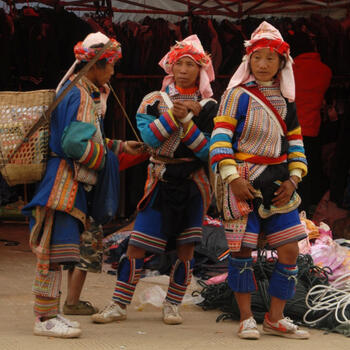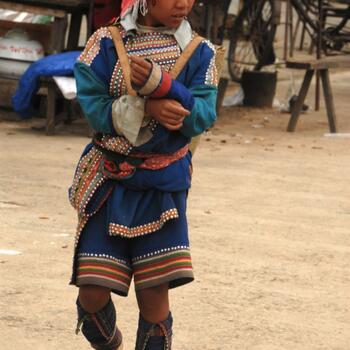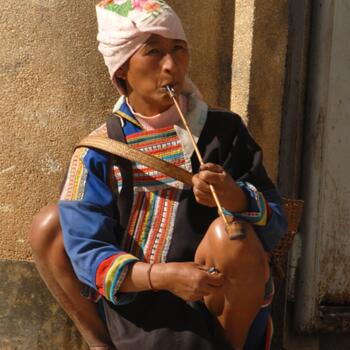Quick Menu
Lincang Prefecture (临沧市) in southwest Yunnan is one of the least explored parts of the province. Counties in the south are home to sizable Dai and Wa indigenous communities, as well as smaller groups of De'ang, Lahu, Yi and Bulang. But the northern half of the prefecture, and Lincang City itself, are generally ignored because travelers assume there is nothing of particular interest in the area.
Lincang City, known locally by its original name Fengxiang (风翔), lies south of the confluence of the Nanding and Xi rivers. At 1,450 meters altitude, the city rises on a low hill south of the river junction. Streets branching off the main north-south street feature still-traditional Han shop-houses when I visited several years ago. But most buildings elsewhere, like the Grand Hotel, administrative centers and the central bank, were very modern, with little in the way of Chinese motifs and more influenced by the Shanghai-European style.

The only truly attractive area of town was South Gate Park in the southwest quarter. The upper part is devoted to children's rides and playgrounds, but even here are places where musicians set up to play, while further on is an old-fashioned, two-story teahouse, divided into several small, classical style rooms with elegant furniture and ink-brush paintings on the walls. Nearby is a pond with pavilions and an arched bridge.
Just above the pond is a small zoo. On display were a pair of tigers and black bears, two pairs of different kinds of wolves, four red pandas and a meter-long, web-footed, yellow-toothed badger or gopher that I didn't recognize. The aviary featured cranes, wild chickens, guinea fowl, peacocks and golden pheasants.

Exploring the countryside outside of Lincang
After a day checking out yet another major Yunnan city, I set out on an excursion to Nanmei Lahu District (南美拉祜族乡), 48 kilometers west along a high road that followed the Xi River to its source and then turned south. The road still kept to the high side of the Dananmei River, which flowed far below and divided the hill settlements of the local Lahu people.
The minibus from Lincang ran the route to Nanmei once every afternoon, dropping me off in the township headquarters. It was a small place with a school, hospital and several modern government buildings but not a single hotel. Fellow passengers on the bus kindly arranged for me to stay in the lower floor of a restaurant, where they had a single bed with a toilet down the hall.
Having spotted a couple of Lahu women on the way in, and noticing they were dressed in traditional clothing, I set out for the nearest village, just two kilometers to the north. In contrast to the administrative center, all the Lahu houses I encountered were built in the traditional style — brick and wood with railed balconies on the upstairs floors, sitting on the ground for the most part, although a couple were raised on low stone piles, with wood tile or corrugated iron roofs.

No temples or churches existed anywhere, though a few field shrines were visible scattered among the heavily terraced slopes. The road runs evenly along the ridge for several kilometers at an altitude of about 1,900 meters. Terraces dominate the slopes on the western side all the way down to the river, and a few villages lie near the river on both banks. Occasional groves of trees, especially downhill closer to the river, separate the terraced sections.
This village seems to be the ceremonial center for Lahu communities in the vicinity. The entrance at the front consists of long, twin stone staircases, with a row of stone blocks running between them and a small water-wheel sculpture halfway to the top. A big mortar bowl sits at the foot of one staircase, though made of concrete, and a wooden gateway with an overhead horizontal beam rises above the first steps.
Past the water-wheel sculpture, the stairway ascends more steeply to end at a square at the beginning of the settled area. The village meeting hall sits here, a very wide building on stone piles with walls of plaited split bamboo and lots of tables and chairs inside. An enclosed pond lies beside it, decorated with a small water-wheel model, though not in actual use. In fact, I didn't see any other water-wheels in the area, nor any streams near their fields, where water wheels might have been used. Perhaps it was a cultural symbol, a relic of earlier centuries when the Lahu lived on the plains.

The villagers didn't seem disturbed by a foreigner in their midst, and just carried on with their daily chores — preparing a slaughtered pig or embroidering cloth. They were polite and didn't mind my interruption or taking photos, but did not invite me in for a drink the way the Wa and Yi did everywhere I met them in the prefecture.
During the Han dynasty a proto-Lahu people known as the Kunming occupied the pastoral areas further north around contemporary Dali (大理州). The Lahu evolved out of this ethnic group and were famous hunters in the Wuliang Mountains, noted for their skill at killing tigers. The name 'Lahu' actually means 'tiger-eaters' in dialect. Up until today, the Dai and other neighbors, both in Yunnan and in Myanmar, Thailand and Laos, generally refer to them not as Lahu but as 'Museur', meaning hunter.
As a consequence of the rise of the Nanzhao Kingdom in the eighth century, the Lahu were forced out of the plains and moved south to live in the hills. About 460,000 now reside in Yunnan — in Lincang, Pu'er, Xishuangbanna and Honghe prefectures. They are divided into several sub-groups, named after the prominent color of the women's traditional clothing. I don't know whether the Nanmei district Lahu were called the Blue Lahu, but that color dominated the female clothing components, providing the basic background for their apparel.
Lahu apparel
They wore a long-sleeved, side-fastened coat that reached to the calves and was split on both sides. Under this they wore a blouse, knee-length shorts and leg-wrappers. Most jackets were a medium blue, with some older women preferring black. These were heavily trimmed with bands of embroidery or thin, appliquéd cloth strips of bright colors on the cuffs, hems, collars, lapels and shoulder blades.
Shorts were similarly enhanced around the knees, the leg wrappers even more so. Like the coats, they revealed individual characteristics that were still recognizably the local Lahu style. They could be folded over at the top, studded with little silver discs or completely appliquéd. Most women tucked the front flap of their jackets into their waistbands to better show off the shorts and leg-wrappers and their embellishments more clearly. A few dressed without leg-wrappers at all.
There seemed to be no uniformity to the headgear. Most simply wrapped their hair in a headscarf. Some piled their hair into a cone and wrapped a peaked white cloth around it, which draped on each side to the shoulders, and kept it in place with a colored cloth around the brow. The most common jewelry was big silver hoop earrings. A few wore silver bangles, but the Lahu around Nanmei were in general less ornamented than other ethnic minorities in Yunnan.

Market day
Back in Nanmei town there is nothing to do at night, for both shops and restaurants close a couple hours after dark. I ate dinner just after sunset, then retired to my room for the night and woke early to see the morning cloudlets floating just above the valley. I was wondering what I should do, whether it would be worth it to hike down to the villages close to the river just to see if daily life there was any different from that in the nearby villages I had already visited.
Then I noticed tables and stalls being set up in the central square. "Gangai?" I asked one of the men involved. "Dui," he replied. Yes, it was market day, held in Nanmei every five days, I later learned. So I stayed another day and night. Villagers began streaming into Nanmei from about 8:30am, from both the north and south. Like market days elsewhere in Yunnan, women constituted at least 80 percent of those in attendance. And in Nanmei the women were mainly consumers, as only a few ran stalls themselves or brought goods in to sell. Instead, the Han Chinese made up the vast majority of the vendors.
No other minority nationality lives in the district, so those attending were nearly all Lahu, mostly women and all dressed up in their finest traditional garments for the occasion. The parameters of the distinctive local style allow for much individuation in the trimmings and embellishments. No two outfits were alike. Sometimes the headscarves resembled others, sometimes not. Teenage girls left their hair uncovered. The hoop earrings were the same for most, and the cut of the clothing components was standard. But the colors, embroidery, use of silver studs and colors for the appliquéd strips differed completely from one woman to another.

Lahu men were a small part of the crowd and did not wear anything especially traditional. Boys and young men dressed in ordinary modern clothes, while older men wore dark blue jackets and trousers. The women provided the color and to an outside observer like myself, Nanmei on market day was like an ethnic fashion parade.
By mid-morning the streets were getting crowded, though it was never very congested. Red umbrellas stood over a line of stalls along the street south of the square, and Lahu women browsed them individually or in small groups. Merchants sold rice, vegetables and seeds, thread, strips of embroidered cloth, shoes, spices and tobacco, the latter being one of the most popular items.
Along with rice and maize, tobacco is one of the main crops in the Nanmei area. And the Lahu love smoking, especially the women. Using small pipes with very long, thin bamboo stems, they smoke while walking to the market and continue puffing away while ambling around the stalls. Older men use pipes with shorter stems, while younger ones prefer cigarettes. Only among the Wa had I witnessed such a large percentage of women smokers. In Nanmei virtually every woman over thirty seemed to be smoking.

In keeping with the traditional look, the women carried pack baskets of woven split bamboo — made by the men of the household — to bring in or take back their goods. A few women led ponies, but other than chickens, these were the only animals in town that day. There were no buffalo, cattle or pigs at the market. Except for a few small noodle stands and one fellow selling steamed buns, the market didn't have any place offering a decent meal. I went back to the restaurant where I was lodging for lunch, then returned to the market to find it just as active, and just as leisurely as before.
No haggling took place at the stalls. Nobody seemed to be in any kind of hurry, either. Women chatted with each other a long time while they examined thread, bolts of cloth or sacks of tobacco. I slipped into the same relaxed, laid back mood myself. If someone got in the way when I was trying to photograph a Lahu woman, I didn't bother to jump up and go pursue the shot. Another photogenic lady would come along, or maybe the other one wwould return. Nobody shunned the camera or gestured for me to stop. For that matter, no one really paid me any attention at all, men included.
The square remained crowded past 2pm, and then the crowd began gradually thinning. By 4:30 the stalls and umbrellas came down and the last Lahu shoppers slung their baskets of goods over their backs and headed home to their villages. It was not the usual kind of market day for me, even when compared with other parts of Lincang Prefecture. My experiences included local minorities approached me for a brief conversation or even inviting me for a snack or a drink to continue the encounter. Yet the Nanmei markets was still quite enjoyable, if only for the plethora of traditional clothing.

It was also an example of the uneven influence of modernization on Yunnan's traditional cultures. Nanmei is not a remote outpost like in the past. Good roads connect it to Lincang and some of the Lahu make the journey to the city on their motorbikes. The district has electricity in all of its villages, televisions in the homes, government offices and a school in town — all the right influences that have elsewhere eroded traditional customs and practices.
Yet the Lahu in Nanmei are far less affected by these developments. They accept modern improvements in their lives, but have retained everything in their culture that makes them distinctly Lahu. There must be more places like that in Yunnan, waiting to be discovered and appreciated. I'm hoping I find them.
Editor's note: This article by author Jim Goodman was originally published on his website Black Eagle Flights (requires proxy). There you can find accounts and photos of Goodman's 40 years in China and Southeast Asia. Collections of his works — many of them about Yunnan — can be purchased on Amazon and Lulu. Goodman has also recently founded Delta Tours, where he guides cultural and historical journeys through Vietnam and western Yunnan.

Uncredited images: Jim Goodman
© Copyright 2005-2024 GoKunming.com all rights reserved. This material may not be republished, rewritten or redistributed without permission.


















Comments
Awesome article, the Lahu are as diverse as they are fascinating and I have never had an opportunity to know more about Lahu outside of the 边三县 region. I feel like there are many characteristics of these Lahu that almost seem very Miaoesque, at least in clothing. Thanks Jim for an awesome article!
Among other things, Jim's an encyclopedia of ethnic detail, and most of the entries are based on his own explorations over many years, backed up by plenty of reading. Though I'm not personally so interested in details of clothing, I do wish I had his very fine observer's eye.
"....a proto-Lahu people known as the Kunming..."
Is that where the city's name comes from?
Login to comment